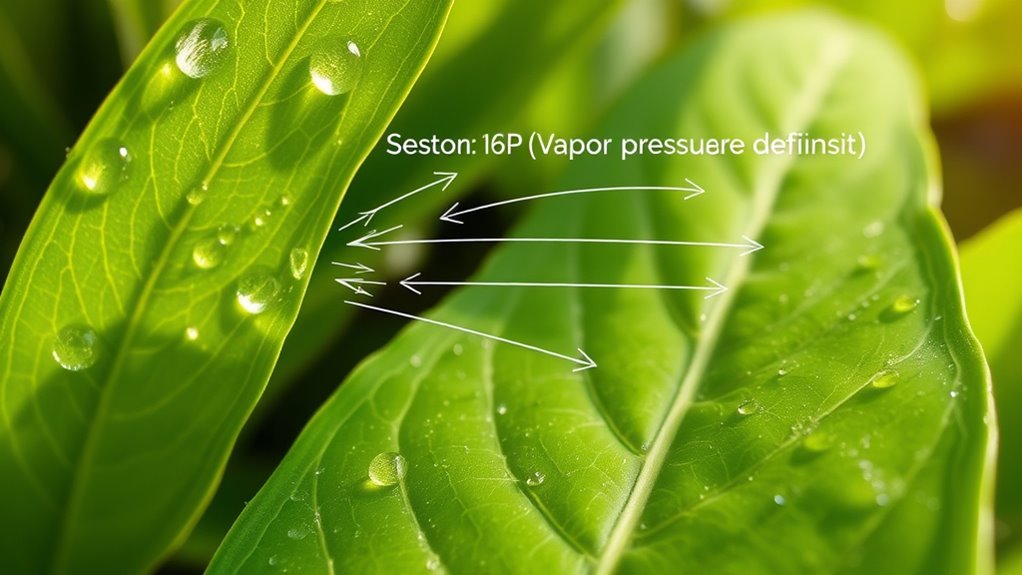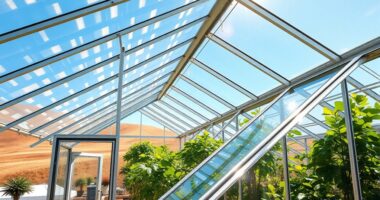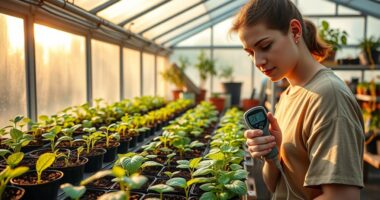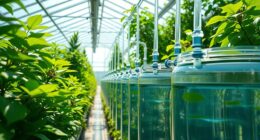Understanding VPD and plant health is vital because it shows how humidity and temperature affect water loss and nutrient uptake. When VPD is too high, plants lose water rapidly, causing stress; too low, and they struggle to transpire properly. Maintaining the right balance helps keep your plants healthy, resilient, and productive. By mastering these factors, you set the stage for better growth, and discovering more will help you optimize your plant environment effectively.
Key Takeaways
- Vapor Pressure Deficit (VPD) measures the moisture difference between air and plant leaves, affecting transpiration and nutrient uptake.
- Proper VPD levels balance water loss and absorption, reducing plant stress and promoting healthy growth.
- Humidity and temperature control directly influence VPD, impacting plant resilience and productivity.
- Imbalanced VPD can cause issues like leaf curl, yellowing, or poor nutrient absorption, harming overall plant health.
- Mastering VPD management optimizes plant environment, improving growth, resistance, and yield across growth stages.
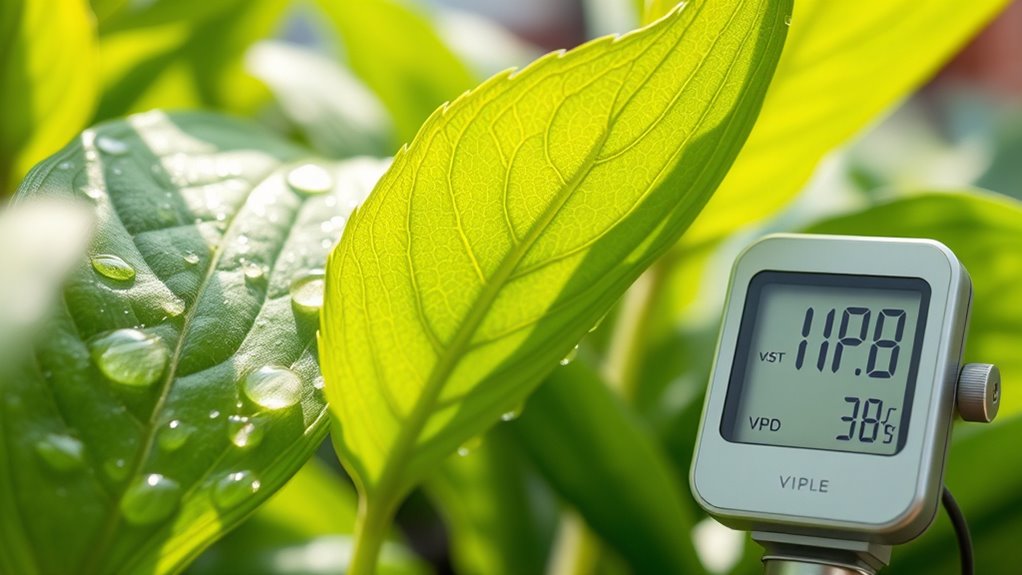
Have you ever wondered how the balance of humidity and temperature affects your plants’ health? It’s a critical factor that influences how well your plants grow and how resilient they are against diseases. At the core of this balance is the concept of Vapor Pressure Deficit (VPD), which essentially measures the difference between the moisture in the air and the moisture the plant’s leaves can hold at a given temperature. When VPD is too high, your plants lose water quickly through transpiration, which can stress them out and hinder growth. Conversely, if VPD is too low, plants may not transpire enough, leading to issues like poor nutrient uptake and increased susceptibility to pests and diseases. Managing VPD requires a keen understanding of humidity control, as both humidity and temperature directly influence transpiration rates. Using proper techniques to monitor and adjust environmental factors can significantly improve plant health and yield.
Balancing humidity and temperature is vital for optimal plant health and growth.
Humidity control becomes a crucial part of maintaining ideal VPD levels. When humidity is high, the air is saturated with moisture, reducing transpiration rates and making it harder for plants to cool themselves or absorb nutrients effectively. On the other hand, low humidity accelerates transpiration, often excessively drying out the plant tissues and causing stress. To keep your plants healthy, you need to monitor and adjust humidity levels carefully, especially in enclosed environments like greenhouses or grow tents. Using tools like hygrometers and humidifiers allows you to fine-tune the environment, ensuring that humidity stays within the range that promotes steady transpiration rates. This balance helps your plants maintain proper water uptake, nutrient absorption, and overall metabolic processes. Additionally, understanding collagen and hyaluronic acid benefits in skincare can serve as a metaphor for nurturing the delicate tissues of your plants.
Understanding the dynamics between humidity control and transpiration rates helps you prevent common problems such as leaf curl, wilting, and nutrient deficiencies. When transpiration rates are ideal, plants can efficiently move water and nutrients from the roots to the leaves, supporting healthy growth and robust development. If you notice signs of stress, like yellowing leaves or slowed growth, it might be time to reassess the humidity levels and VPD. Regular environmental checks and adjustments create an environment where your plants can thrive, with steady water movement and minimal stress.
Ultimately, mastering VPD and maintaining proper humidity control empower you to create a stable environment tailored to your plants’ needs. It’s about striking a balance—ensuring transpiration rates aren’t too high or too low—so your plants can grow vigorously and resist environmental stresses. By paying close attention to these factors, you enhance your plant’s health and maximize their potential, leading to healthier, more productive growth in every stage.
Frequently Asked Questions
How Does VPD Affect Different Plant Species Uniquely?
VPD affects different plant species uniquely because each has specific adaptations to moisture levels. You’ll notice that some species thrive in high VPD conditions, showing rapid growth rates, while others slow down or suffer under the same circumstances. By understanding their species adaptation, you can optimize watering and humidity, ensuring your plants maintain healthy growth rates and avoid stress, especially for sensitive or drought-adapted varieties.
Can VPD Levels Be Adjusted Manually for Optimal Plant Growth?
Ever wondered if you can tweak VPD levels for better plant growth? Yes, you can manually adjust VPD through environmental control methods like regulating humidity and temperature. By monitoring and making precise adjustments, you create ideal conditions for your plants. This hands-on approach helps you optimize growth, improve health, and tailor environments to specific plant needs, giving you better control over your garden or grow space.
What Are the Signs of VPD Stress in Plants?
You’ll notice VPD stress in your plants through signs like leaf curl and wilting symptoms. When VPD is too high, leaves may curl or become dry, indicating excessive transpiration. Conversely, low VPD can cause leaves to stay limp or waterlogged. Pay attention to these signs to adjust your environment, ensuring your plants maintain ideal VPD levels for healthy growth and avoiding stress-related damage.
How Does VPD Interact With Other Environmental Factors?
VPD’s interaction with environmental factors is like a dramatic dance where humidity control and temperature interplay take center stage. When humidity drops, VPD skyrockets, making plants sweat and stress, while high humidity calms the scene. Temperature fluctuations intensify this effect, amplifying VPD’s power. You must carefully balance humidity and temperature to prevent stress, ensuring your plants thrive in this delicate environmental ballet.
Are There Specific Tools to Measure VPD Accurately Indoors?
Yes, there are specific tools for VPD measurement indoors. You can use indoor sensors like digital hygrometers and thermometers that accurately track temperature and humidity. Some advanced sensors even integrate VPD measurement directly, providing real-time data. These tools help you monitor environmental conditions effectively, allowing you to adjust climate controls to optimize plant health. Investing in reliable indoor sensors guarantees precise VPD management for healthy plant growth.
Conclusion
By understanding VPD and its impact on plant health, you gain the tools to prevent issues before they arise. Keeping the right balance is like walking a tightrope—too much or too little can tip the scales against your plants. Pay close attention to environmental cues, adjust conditions accordingly, and you’ll see your plants thrive. Remember, a little extra care can make all the difference, turning a shaky start into a flourishing garden you can be proud of.
